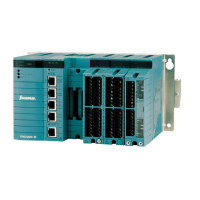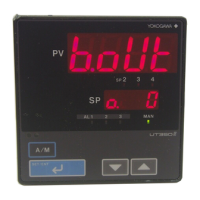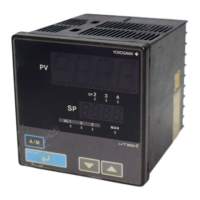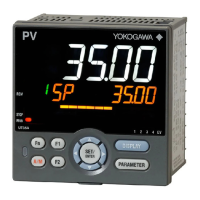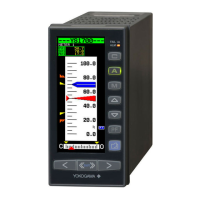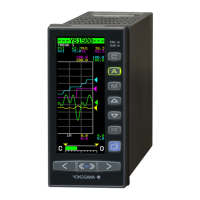4-11
IM 04L20A01-01E
Measurement Input and Alarm Setup Operations
4
Alarm Delay Time (When [Type] is set to [T] or [t])
• First-CH/Last-CH
Select the measurement channels for setting the alarm delay. The target channels
also apply to [Tag] and [Moving average] (or [Filter]) settings.
• Alarm delay time
Set the alarm delay using an integer in the range of [1] to [3600] s.
Note
• If the scan interval is 2 s and you set an odd value for the alarm delay, it will operate at “the
specified period + 1 s.” Example: If the alarm delay set to 5 s, the function will operate at 6 s.
• For a description of the alarm delay setting of computation channels, see section 8.3, “
Setting
Alarms on Computation Channels
.”
Releasing Alarm Output (AlarmACK) <Operation Mode>
The following operation is valid only when [Behavior] is set to [Hold] or [Indicator] is
set to [Hold] in basic setting mode.
Procedure
1. In operation mode, press the FUNC key.
A soft key menu is displayed at the bottom of the display.
2. Press the [AlarmACK] soft key.
Note
This operation can be assigned to the USER key. If it is, alarms can be cleared simply by
pressing a single key. For the procedure in assigning a function to the USER key, see
section 9.1.
Explanation
Alarm Output Release (Alarm ACK) Operation
When you perform the alarm ACK procedure, all alarm displays and relay outputs (/
A1, /A2, /A3 option) are released. However, this procedure is not valid if the alarm
display/output relay operation is set to non-hold. This cancellation procedure can be
performed via remote control (/R1, /PM1 option) or via communication interface.
For information about remote entry of settings, see section 9.6, “
Using the Remote Control
Function (/R1, /PM Option).
” For information about communication functions, see the
“FX100
Communications Interface User’s Manual
” (IM 04L20A01-17E).
4.2 Setting Alarm Related Parameters

